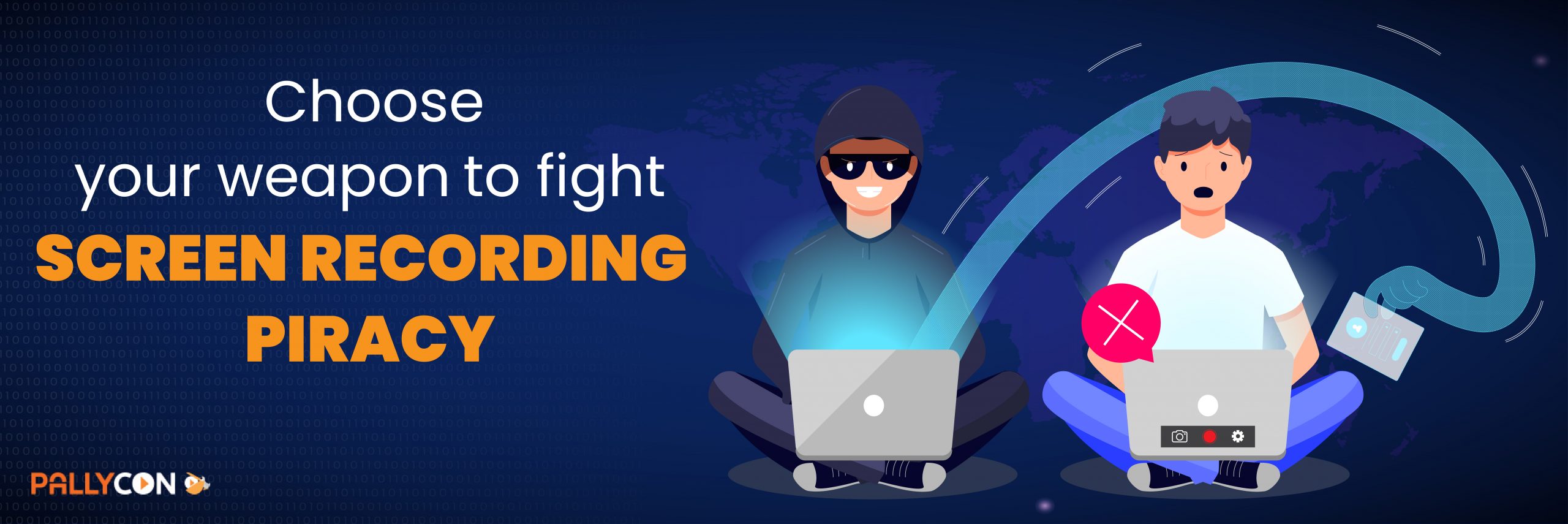
Choose Your Weapon to Fight Screen Recording Piracy
The history of the content industry has been accompanied by the fight against illegal content leakage. The so-called ‘cam version’ is one of the most traditional methods for movie content piracy.
The movie industry, which has made theater releases difficult due to the coronavirus, is releasing the latest content through various OTT services instead. Now, anyone can illegally record and leak the latest releases at home, without the need to secretly film in the theater.
There are two types of piracy by screen recording:
- Using a screen recording app
When using various screen recording applications to save DRM video played on PC or mobile as a video file. - Using a camera
When recording DRM video on a PC, mobile or TV screen using equipment such as a smartphone camera or camcorder.
Let’s see how you can prevent screen recording for each type.
Content piracy using screen recording app

There are various PC and mobile applications that provide a screen recording function. Although it is not illegal to use the application itself, the recording function can be used for illegal copying of content.
You can prevent this piracy by blocking the recording function itself in the following way.
Prevent recording by applying multi-DRM
Encrypting content with multi-DRM is the basis of content security and the strongest prevention against screen recording. In the case of DRM provided by the client platform as below, recording can be reliably prevented without a separate solution.
- PlayReady: Edge/IE11 browser for Windows, UWP app
- FairPlay Streaming: Safari browser and apps on all Apple devices
- Widevine: Android app
However, there are cases where it is not possible to prevent recording by applying multi-DRM alone. This is about web browsers with software-level Widevine DRM such as Chrome and Firefox.
In particular, the Chrome browser has a high share of the PC environment, so it can be a big problem that Widevine DRM content played on Chrome can be easily duplicated with a screen recording app.
Limit supported browser or content resolution
As an alternative to the anti-capture solution, service providers can decide not to support those browsers (Chrome, Firefox, etc.) that are vulnerable to screen recording. In this case, it can be inconvenient for end users to use a different browser that they are not used to.
Another way to minimize user discomfort is to limit the resolution of the content served to the browsers. If you limit the content serviced to browsers such as Chrome to 720p or 576p, the damage caused by leaked content can be minimized.
Related Article – DRM for All Screen Types? Not So Straight Forward
Screen recording using camera

Multi-DRM and anti-capture solutions can prevent screen recording within the client device, but cannot prevent screen recording from outside the device using a camera.
Content leaked in this way can be prevented by using a watermarking solution.
Display watermark text on video
A visible watermarking solution displays visible text on top of the video being played. By displaying the ID of the service user or the IP address of the client device on the screen, the user can be tracked from the content leaked by screen recording.
In addition, the user information displayed on the screen can be expected to suppress illegal leakage itself.
Apply forensic watermarking solution
Although a visible watermarking solution is relatively inexpensive and simple to implement, it can harm the user’s content experience and may be removed by video editing.
For your information, PallyCon’s Visible Watermarking solution can make watermark text appear and disappear at random locations and times instead of a fixed watermark, making it safe from video editing attacks.
Forensic watermarking is a solution that compensates for these shortcomings by inserting user information into the video as an invisible watermark. It is not removed even in various attacks such as re-encoding, filtering, and aspect ratio change, and user information can be extracted from contents leaked in various ways to track and block the piracy.
Related Article – Forensic Watermarking for Premium Online Video Contents
Summary
Among various methods of illegal content leakage, screen recording has very low technical difficulty, so it can be easily tried not only by professional hackers, but also by any people. As the use of OTT service increases, the need for a solution that can cope with screen recording is also increasing.
As a professional content security service, PallyCon provides various solutions that can be your weapon against screen recording piracy.
Daniel is a DRM specialist and has been associated with this industry for over 10 years. Other than this, he is addicted to reading and writing.

